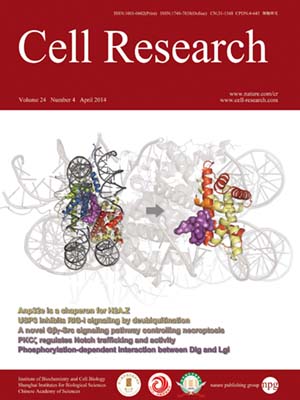
Volume 24, No 4, Apr 2014
ISSN: 1001-0602
EISSN: 1748-7838 2018
impact factor 17.848*
(Clarivate Analytics, 2019)
Volume 24 Issue 4, April 2014: 389-399 | Open Access
ORIGINAL ARTICLES
Anp32e, a higher eukaryotic histone chaperone directs preferential recognition for H2A.Z
Zhuo Mao1,2,*, Lu Pan3,*, Weixiang Wang4,*, Jian Sun2, Shan Shan3, Qiang Dong2, Xiaoping Liang3, Linchang Dai3, Xiaojun Ding2, She Chen2, Zhuqiang Zhang2,3, Bing Zhu1,2,3 and Zheng Zhou3,5
1Graduate Program, Peking Union Medical College and Chinese Academy of Medical Sciences, Beijing 100730, China
2National Institute of Biological Sciences, Beijing 102206, China
3National Laboratory of Biomacromolecules, Institute of Biophysics, Chinese Academy of Sciences, Beijing 100101, China
4College of Plant Science and Technology, Beijing University of Agriculture, Beijing 102206, China
5Center for Age-related Diseases, Peking University Health Science Center, Beijing 100191, China
Correspondence: Zheng Zhou, E-mail: zhouzh@sun5.ibp.ac.cn; Bing Zhu, E-mail: zhubing@nibs.ac.cn; Zhuqiang Zhang,(zhangzhuqiang@nibs.ac.cn)
H2A.Z is a highly conserved histone variant in all species. The chromatin deposition of H2A.Z is specifically catalyzed by the yeast chromatin remodeling complex SWR1 and its mammalian counterpart SRCAP. However, the mechanism by which H2A.Z is preferentially recognized by non-histone proteins remains elusive. Here we identified Anp32e, a novel higher eukaryote-specific histone chaperone for H2A.Z. Anp32e preferentially associates with H2A.Z-H2B dimers rather than H2A-H2B dimers in vitro and in vivo and dissociates non-nucleosomal aggregates formed by DNA and H2A-H2B. We determined the crystal structure of the Anp32e chaperone domain (186-232) in complex with the H2A.Z-H2B dimer. In this structure, the region containing Anp32e residues 214-224, which is absent in other Anp32 family proteins, specifically interacts with the extended H2A.Z αC helix, which exhibits an unexpected conformational change. Genome-wide profiling of Anp32e revealed a remarkable co-occupancy between Anp32e and H2A.Z. Cells overexpressing Anp32e displayed a strong global H2A.Z loss at the +1 nucleosomes, whereas cells depleted of Anp32e displayed a moderate global H2A.Z increase at the +1 nucleosomes. This suggests that Anp32e may help to resolve the non-nucleosomal H2A.Z aggregates and also facilitate the removal of H2A.Z at the +1 nucleosomes, and the latter may help RNA polymerase II to pass the first nucleosomal barrier.
10.1038/cr.2014.30
FULL TEXT | PDF
Browse 2195


